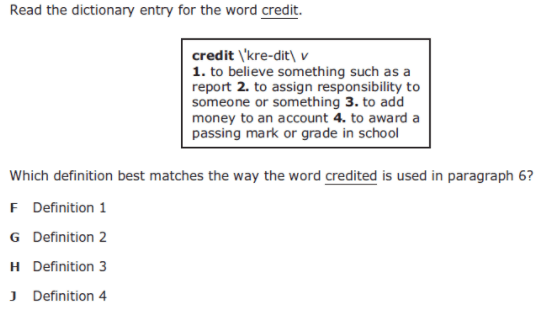THE TURNING POINT IN THE STORY; THE POINT IN A STORY WHEN THE CONFLICT MUST BE SOLVED
CLIMAX
When reading an informational text the ___________ __________________ helps the reader understand the organization of text.
A. Figurative language
B. Text structure
C. Plot elements
D. Main idea
B. Text structure
When reading a poem, which items should I be looking for as I annotate?
A. Summary with main idea
B. Text structure
C. Plot elements
D. Mood, tone and a shift
D. Mood, tone and a shift
The following strategies can help you determine word meaning, except:
a. context clues
b. dictionary
c. root words
d. your neighbor
d. your neighbor
a. picture
b. highlight
c. show
d. support
c. show
Annotations in Fiction should include all, except which of the following?
a. stage directions
b. theme
c. characterization
d. elements of plot
a. stage directions
Informational/Non-fiction text usually have a ________ __________ text structure where information is told in order
a. cause and effect
b. problem and solution
c. logical/sequential order
d. compare and contrast
c. logical/sequential order
Authors use _____________ ______________ to say what they really mean, but with more descriptive language
a. context clues
b. figurative language
c. main ideas
d. dictionary skills
b. figurative language
When a question asks to determine a word's meaning by how it's used in a sentence, you should look for:
a. answers
b. bolded words
c. context clues
d. a dictionary
c. context clues
Which of the following means the same thing as emphasize?
a. support
b. picture
c. show
d. make important
d. make important
True or False?
A theme is usually stated in the details of the story.
False.
A theme is usually inferred by looking at the setting, plot, problems, characters and their actions.
True or False?
Annotations in a Non-fictional/Informational text should be about the details instead of the main idea.
False
What do you do to a poem before you begin reading and annotating?
Number the lines and stanzas
Where can I find out if a word is noun, verb, adjective or adverb?
In the dictionary! (noted as 'n', 'v', 'adj' or 'adv')
Which word means the same as to illustrate?
a. explain
b. relate
c. show
d. determine
c. show
The theme in a work of fiction is:
a. the author's purpose
b. the climax
c. the character development
d. the message an author wants you to take from the story
d. the message an author wants you to take from the story
When reading a non-fiction text, annotations should also include the author's ____________
a. name
b. mood
c. age
d. purpose
d. purpose
A poet often uses things like italics, or repetition to _____ something.
a. emphasize
b. illustrate
c. convey
d. show
a. emphasize
Which strategies should you use to answer the following?

*re-read the sentence the word is in
*substitute the definition in the sentence
Which word best means to emphasize?
a. show
b. illustrate
c. make important
d. italicize
c. make important
When making annotations about characters we look at two major types of conflict. What are they?
Internal and External
What type of text structure is the following topic?: The principal realized students were using Chromebooks improperly, so they took away the student's privilege to use them.
a. logical/sequential order
b. cause and effect
c. compare and contrast
d. problem and solution
d. problem and solution
This word describes a change in mood or tone of a poem
Shift
Which line from the following entry gives context clues about the word amiable?
I found the new student to be amiable. There was simply something so pleasant and friendly about his manner.
pleasant and friendly
True or False: Any time you read a question that asks you to infer, the answer will always be words taken directly from the text.
False!
Inferences are NOT found word for word in the text because in order to make an inference you have to put evidence from the text together with what you know to come to a new understanding/conclusion.